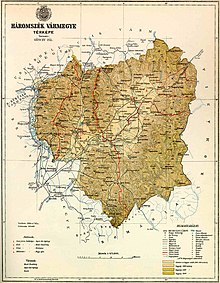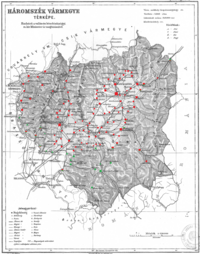Háromszék County
| Háromszék County | |
|---|---|
| County of the Kingdom of Hungary (1876-1920, 1940-1945) | |
 | |
| Capital | Sepsiszentgyörgy |
| Area | |
| • Coordinates | 45°52′N 25°47′E / 45.867°N 25.783°E |
• 1910 | 3,889 km2 (1,502 sq mi) |
| Population | |
• 1910 | 148,100 |
| History | |
• Established | 1876 |
| 4 June 1920 | |
• County recreated (Second Vienna Award) | 30 August 1940 |
• Disestablished | 20 January 1945 |
| Today part of | Romania |
| Sfântu Gheorghe is the current name of the capital. | |
Háromszék (Three Seats; Romanian: Trei Scaune) was an administrative county (comitatus) of the Kingdom of Hungary. Situated in south-eastern Transylvania, its territory is now in central Romania (in the counties of Covasna, Brașov, and Bacău). The capital of the county was Sepsiszentgyörgy (now Sfântu Gheorghe).
Geography

Háromszék county shared borders with Romania and the Hungarian counties Csík, Udvarhely, Nagy-Küküllő, and Brassó. The river Olt flowed through the county. The Carpathian Mountains formed its southern and eastern border. Its area was 3,889 km2 (1,502 sq mi) around 1910.
History
Háromszék means "three seats". Háromszék County was a combination of three seats of the Székelys: Kézdiszék, Orbaiszék, and Sepsiszék (plus some villages of the former Felső-Fehér County). The county was formed in 1876, when the administrative structure of Transylvania was changed.
In 1920, under the Treaty of Trianon, the county became part of the Kingdom of Romania under the name Trei Scaune. After the Second Vienna Award of August 1940, the county was recreated with most of its historic territory as it became part of the Northern Transylvania territory of Hungary again until October 1944, towards the end of World War II.
Afterward, it became part of Romania again; its territory lies mainly in the present Romanian county of Covasna, with a small part in the south being part of Brașov County.
Demographics

| Census | Total | Hungarian | Romanian | Other or unknown |
|---|---|---|---|---|
| 1880[1] | 125,277 | 104,607 (86.57%) | 15,448 (12.78%) | 783 (0.65%) |
| 1890[2] | 130,008 | 110,799 (85.22%) | 17,360 (13.35%) | 1,849 (1.42%) |
| 1900[3] | 137,261 | 116,755 (85.06%) | 19,439 (14.16%) | 1,067 (0.78%) |
| 1910[4] | 148,080 | 123,518 (83.41%) | 22,963 (15.51%) | 1,599 (1.08%) |
| Census | Total | Calvinist | Roman Catholic | Eastern Orthodox | Unitarian | Greek Catholic | Other or unknown |
|---|---|---|---|---|---|---|---|
| 1880 | 125,277 | 54,548 (43.54%) | 41,468 (33.10%) | 21,338 (17.03%) | 5,029 (4.01%) | 1,962 (1.57%) | 932 (0.74%) |
| 1890 | 130,008 | 55,869 (42.97%) | 43,224 (33.25%) | 22,529 (17.33%) | 4,985 (3.83%) | 2,404 (1.85%) | 997 (0.77%) |
| 1900 | 137,261 | 57,861 (42.15%) | 45,681 (33.28%) | 24,761 (18.04%) | 5,102 (3.72%) | 2,465 (1.80%) | 1,391 (1.01%) |
| 1910 | 148,080 | 60,030 (40.54%) | 49,654 (33.53%) | 28,077 (18.96%) | 5,228 (3.53%) | 3,052 (2.06%) | 2,039 (1.38%) |
Subdivisions

In the early 20th century, the subdivisions of Háromszék county were:
| Districts (járás) | |
|---|---|
| District | Capital |
| Kézdi | Kézdivásárhely (now Târgu Secuiesc) |
| Miklósvár | Nagyajta (now Aita Mare) |
| Orbai | Kovászna (now Covasna) |
| Sepsi | Sepsiszentgyörgy (now Sfântu Gheorghe) |
| Urban districts (rendezett tanácsú város) | |
| Kézdivásárhely (now Târgu Secuiesc) | |
| Sepsiszentgyörgy (now Sfântu Gheorghe) | |
Notes
References
- ^ "Az 1881. év elején végrehajtott népszámlálás főbb eredményei megyék és községek szerint rendezve, II. kötet (1882)". library.hungaricana.hu. Retrieved 28 September 2021.
- ^ "A Magyar Korona országainak helységnévtára (1892)". library.hungaricana.hu. Retrieved 29 September 2021.
- ^ "A MAGYAR KORONA ORSZÁGAINAK 1900". library.hungaricana.hu. Retrieved 29 September 2021.
- ^ "KlimoTheca :: Könyvtár". Kt.lib.pte.hu. Retrieved 29 September 2021.


